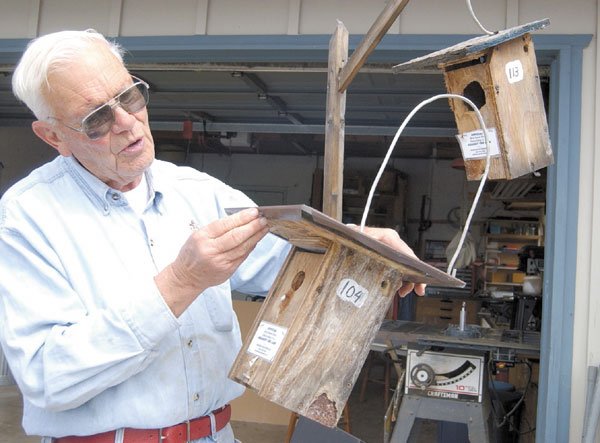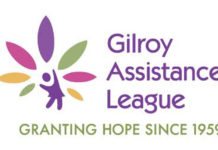If you hang a bird feeder, they will come. Well, it’s almost
that simple. Follow these tips to appease our feathered friends
They seem like such simple, logical things: If you want to feed the birds, buy a bird feeder. If you want birds to build nests in your back yard, buy a birdhouse. But what seems like simple logic is actually more complicated. Attracting native South Valley birds to your yard takes more than sticking a birdhouse or feeder outside.
“Birds want a good place to raise their young,” said Norman Watenpaugh, a Gilroy resident, Audubon Society member and bird aficionado. “They want food, water and shelter. But it has to be the right kind of shelter.”
Despite the festive appearance of some birdhouses available at retail stores, cavity nesting birds really prefer houses that are simple, wood and closely resemble trees, Watenpaugh said. Though different birds like different sized boxes and holes, most cavity nesting birds do have one thing in common: They’re running out of places to live.
Most cavity nesters use holes in rotting posts or trees or holes made by woodpeckers, Watenpaugh explained. Because most people clear rotting trees and posts, and woodpeckers can only make so many holes, cavity nesters are relying more and more on humans to survive, according to the National Audubon Society.
To do your part in conserving cavity nesters, start by paying attention to what kinds of birds are already visiting your yard, said Jill Himonas, owner of the Wild Bird Center in Monterey.
“When you have a better idea of what kind of birds come into your yard, you’ll know what kind of box you should get to have the best chance of having a bird nest in it,” she said. “You can buy birdhouses many places, but when you talk to people who specialize in birds, like us, you can get information in how to attract birds you’d like to see in your yard, such as songbirds rather than pigeons, how to keep your feeders and birdhouses clean, and how to avoid predators.”
Predators can be a problem around bird feeders and birdhouses. The construction of birdhouses can help prevent many predators from reaching birds that have settled in your yard, Watenpaugh said.
“By hanging them up (with a hook) and putting the bigger, tilted roof on it, raccoons can’t reach in,” he explained. “If you have a tin roof with the edges turned under, mice have a hard time getting in the hole, too.”
Perches found on most commercially sold birdhouses should be taken off immediately, Himonas said.
“If you think about it, these birds would normally be living in a tree, and trees don’t have perches,” she said. “Perches really help predators by giving them a foothold to get inside to the babies or the eggs. The birds in there are really sitting ducks, no pun intended.”
When using a decorated birdhouse, know that some bright colors may scare birds off, Watenpaugh said. Also, make sure the paint used isn’t toxic to birds, and never paint the inside of the box, Himonas said.
If you don’t have a back yard, or if yours isn’t the right habitat for birds, you can still enjoy the pleasures of having a birdhouse, Watenpaugh said. As part of the cavity nesting birds conservation, the Audubon Society has placed more than 80 birdhouses in local parks and other areas birds frequent. The society is looking for volunteers to walk along trails where the houses are located to see if they are in use, to see what kind of birds have made a home inside, and to make sure the houses aren’t damaged or in need of a cleaning. Contact the Audubon Society for more information.
The Hummingbird Diet
Hummingbirds drink nectar. To attract hummingbirds, purchase a specialized hummingbird feeder. Then create a sugar solution by mixing one part white sugar to four parts water. Boil briefly to sterilize and dissolve sugar crystals. Feeders must be washed every few days with very hot water to prevent mold growth.
Source: National Audubon Society
Selecting Seeds for Feeders
Different kinds of birds like different kinds of seeds. Be aware of what kind of birds you have in your back yard most often.
Sunflower seeds: jays, red-bellied woodpeckers, finches, goldfinches, northern cardinals, evening grosbeaks, pine grosbeaks, chickadees, titmice, nuthatches and grackles.
Millet: quail, doves, juncos, sparrows, towhees, cowbirds and red-winged blackbirds.
Cracked corn: quail, crows, doves, jays, sparrows, juncos and towhees.
Thistle (nyjer): goldfinches, house finches, common redpolls and lesser goldfinches.
Suet and “bird puddings” (beef fat and seed): woodpeckers, wrens, chickadees, nuthatches and titmice.
Peanuts: woodpeckers, jays, chickadees, titmice, bushtits, nuthatches, wrens and pine warblers, among others.
Source: National Audubon Society
How To Pick Feeder Locations
– Be aware of how close to windows your feeders are. You don’t want birds running into windows and hurting themselves in an attempt to get to the feeder. Nearly 1 billion birds die every year after flying into windows.
– Keep cats indoors, or they may prowl on birds at the feeder. Bells on cats collars also help prevent them from sneaking up on unsuspecting birds.
– Use “bafflers,” which often resemble upside-down funnels, that go around posts leading to feeders. Squirrels, mice and other “thieves” can’t make it up the pole to steal the food with bafflers in place.
– Buy squirrel feeders, and place them at the opposite side of the yard from bird feeders. This distracts the squirrels so birds can eat safely. Keep in mind that squirrels can jump as far as 6 feet, so keep the squirrel feeders at least 7 feet away from trees and branches.
– Many specialized feeders help prevent larger birds such as blackbirds or pigeons from eating and cater to smaller songbirds.
Source: National Audubon Society
Also Online
For more information on birdhouses, helping to conserve cavity nesting birds or for help with any other bird-related questions, contact the Santa Clara Valley Audubon Society at (408) 252-3747, the Monterey Peninsula Audubon Society at www.montereyaudubon.org, the California Audubon Society at www.audubon-ca.org or the National Audubon Society at www.audubon.org.













